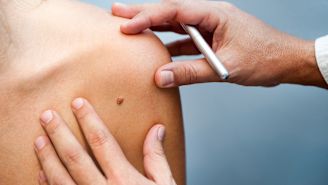Updated on July 5, 2023.
Worried about skin cancer? If you’re debating whether to wear a hat or apply sunscreen before heading outside—go ahead and do it. More than 9 in 10 cases of melanoma in the United States between 2011 and 2015 were attributable to exposure to ultraviolet (UV) rays, like those that come from the sun, according to a study published in 2020 in the International Journal of Cancer. What’s more, researchers discovered that some states had significantly higher rates of UV-linked melanoma than others—and they may not be the states you’d expect.
What is melanoma?
Melanoma is a type of skin cancer that forms in melanocytes, cells located in the lower part of the epidermis. You can develop melanomas on any part of your body. In women, these growths appear most often on the legs. In men, it’s the chest or back. They’re also commonly found on the face and neck.
Though rates have risen steadily over the last few decades, melanoma makes up just 1 percent of new skin cancer cases annually. Approximately 97,610 melanomas will be diagnosed in the U.S. in 2023 according to the American Cancer Society (ACS).
That said, melanoma accounts for most deaths related to skin cancer. This is because, when it’s not detected and treated, it spreads throughout the body more easily than other forms of the disease. The ACS estimates about 7,990 people will die of melanoma in 2023.
Some risk factors for melanoma can be controlled, including a primary risk factor: exposure to UV rays. Most of the UV rays we get come from the sun, though indoor tanning beds are also a chief source for many people. In fact, indoor tanning leads to more than 6,000 cases of melanoma annually, according to the Centers for Disease Control and Prevention (CDC).
Some other risk factors for melanoma can’t be controlled, including age, sex, race, and genetics:
- Though it’s found among younger adults, your chances of developing melanoma rise as you grow older; 65 is the average age of diagnosis.
- The disease is more common in white people, who are 20 times more likely than Black people to develop melanoma, and four times more likely than Hispanic people.
- Men are likelier to develop and/or die of melanoma overall, but women younger than age 50 have higher rates of the disease.
- There is a genetic component. If your family has a history of the condition, your risk increases.
What the study says
Since melanoma risk depends largely on your exposure to UV rays, where you live may affect your chances of developing the disease. The International Journal of Cancer study found that UV-linked melanoma rates varied widely between states. When total state population was considered, Utah was number one in the nation with 36.3 cases per 100,000 residents, followed by Vermont, Delaware, Minnesota, and New Hampshire.
Non-Hispanic white people made up 94.3 percent of all UV-attributable cases of melanoma considered in the study. When just that demographic was considered, UV-linked melanoma rates ranged from 15.1 cases per 100,000 people in Alaska to 65.1 cases for every 100,000 Hawaiians. Utah, Delaware, Georgia, and California also landed in the top five, while Nevada, Washington DC, Indiana, and Texas ended up with the lowest rates.
Researchers theorized that location and elevation accounted for some of the differences. UV rays are stronger in areas closer to the equator. This would help explain why Hawaii—the state closest to the equator—had such a high incidence of UV-linked melanoma among white people. Higher elevations can also mean stronger UV rays, which may be why Utah ranked so highly.
Other factors likely played into UV exposure, as well. These include time spent on outdoor activities, inadequate application of sun protection, use of tanning beds, and practices for early detection. Minnesota had higher rates of UV-linked melanoma—even though it’s more northern and landlocked—possibly for these reasons.
How to lower your odds of melanoma
There is no foolproof way to prevent melanoma, but you can reduce your risk by taking a few wise precautions. First, make sure to safeguard yourself from UV rays. When you head outside, remember to wear the best sunscreen for you, even if the weather is overcast. Just 12.3 percent of men and 29 percent of women always wear sunscreen if they’re going outdoors for more than an hour on a sunny day, according to a 2022 CDC report.
In addition, wear sunglasses, protective clothing and a wide-brimmed hat. During the brightest hours of the day—usually around midday—stick to shady places or stay inside altogether. Avoid tanning beds at all costs.
Be on the lookout for changes in your skin, as well. Check yourself monthly for growths or moles, and report anything new or unusual to a healthcare provider. Regular dermatologist exams may be recommended for some people, especially if they are prone to moles.







